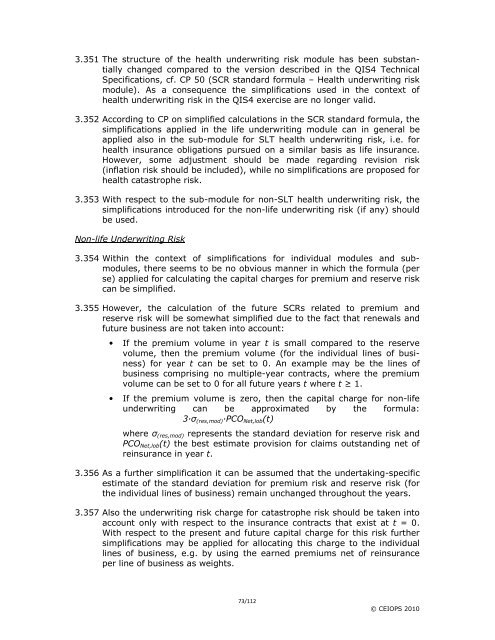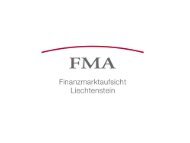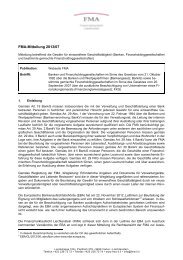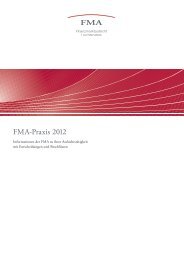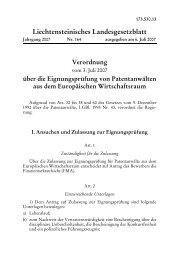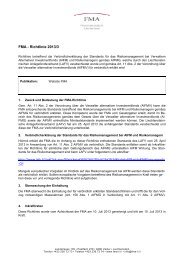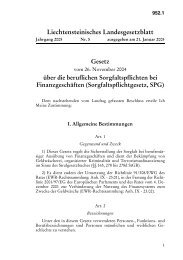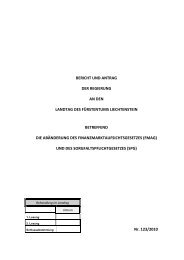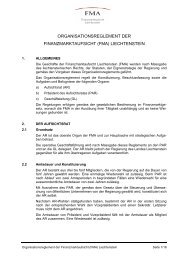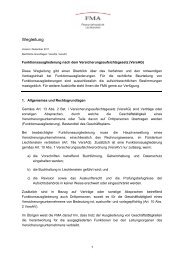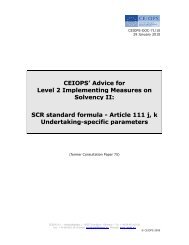CEIOPS' Advice for Level 2 Implementing ... - EIOPA - Europa
CEIOPS' Advice for Level 2 Implementing ... - EIOPA - Europa
CEIOPS' Advice for Level 2 Implementing ... - EIOPA - Europa
Create successful ePaper yourself
Turn your PDF publications into a flip-book with our unique Google optimized e-Paper software.
3.351 The structure of the health underwriting risk module has been substantially<br />
changed compared to the version described in the QIS4 Technical<br />
Specifications, cf. CP 50 (SCR standard <strong>for</strong>mula – Health underwriting risk<br />
module). As a consequence the simplifications used in the context of<br />
health underwriting risk in the QIS4 exercise are no longer valid.<br />
3.352 According to CP on simplified calculations in the SCR standard <strong>for</strong>mula, the<br />
simplifications applied in the life underwriting module can in general be<br />
applied also in the sub-module <strong>for</strong> SLT health underwriting risk, i.e. <strong>for</strong><br />
health insurance obligations pursued on a similar basis as life insurance.<br />
However, some adjustment should be made regarding revision risk<br />
(inflation risk should be included), while no simplifications are proposed <strong>for</strong><br />
health catastrophe risk.<br />
3.353 With respect to the sub-module <strong>for</strong> non-SLT health underwriting risk, the<br />
simplifications introduced <strong>for</strong> the non-life underwriting risk (if any) should<br />
be used.<br />
Non-life Underwriting Risk<br />
3.354 Within the context of simplifications <strong>for</strong> individual modules and submodules,<br />
there seems to be no obvious manner in which the <strong>for</strong>mula (per<br />
se) applied <strong>for</strong> calculating the capital charges <strong>for</strong> premium and reserve risk<br />
can be simplified.<br />
3.355 However, the calculation of the future SCRs related to premium and<br />
reserve risk will be somewhat simplified due to the fact that renewals and<br />
future business are not taken into account:<br />
• If the premium volume in year t is small compared to the reserve<br />
volume, then the premium volume (<strong>for</strong> the individual lines of business)<br />
<strong>for</strong> year t can be set to 0. An example may be the lines of<br />
business comprising no multiple-year contracts, where the premium<br />
volume can be set to 0 <strong>for</strong> all future years t where t ≥ 1.<br />
• If the premium volume is zero, then the capital charge <strong>for</strong> non-life<br />
underwriting can be approximated by the <strong>for</strong>mula:<br />
3·σ(res,mod)·PCONet,lob(t)<br />
where σ(res,mod) represents the standard deviation <strong>for</strong> reserve risk and<br />
PCONet,lob(t) the best estimate provision <strong>for</strong> claims outstanding net of<br />
reinsurance in year t.<br />
3.356 As a further simplification it can be assumed that the undertaking-specific<br />
estimate of the standard deviation <strong>for</strong> premium risk and reserve risk (<strong>for</strong><br />
the individual lines of business) remain unchanged throughout the years.<br />
3.357 Also the underwriting risk charge <strong>for</strong> catastrophe risk should be taken into<br />
account only with respect to the insurance contracts that exist at t = 0.<br />
With respect to the present and future capital charge <strong>for</strong> this risk further<br />
simplifications may be applied <strong>for</strong> allocating this charge to the individual<br />
lines of business, e.g. by using the earned premiums net of reinsurance<br />
per line of business as weights.<br />
73/112<br />
© CEIOPS 2010


